LinkedIn currently boasts over 950 million users across more than 200 countries. With 16.2% of its users logging in daily and 61 million job seekers using it weekly, the platform can easily serve as a powerful component of your HR and recruitment strategy.
From forming connections and posting job listings to building a following and accessing learning and development opportunities, any company can reap many benefits from LinkedIn’s offerings. To realize its full potential, I’ll show you how to maximize the platform.
Why use LinkedIn for HR and recruitment efforts?
Many HR and recruitment strategies are built specifically for LinkedIn — and for good reason.
Recruitment is increasingly digital
As a result of the COVID-19 pandemic, recruitment is now primarily done virtually. In fact, 44% of organizations leverage public information obtained from various platforms, including social media, to speed up their procedures.
Additionally, search filters, AI, and document scanners also help recruiters excel at their jobs. LinkedIn has many of these technologies built in, except you’re looking at profile keywords and settings, social posts, mutual connections, and more, rather than resumes.
Access to a massive, diverse talent pool
Hundreds of millions of professionals use LinkedIn for job seeking, networking, and learning, making it an ideal place for reaching out and connecting with talent. These individuals possess unique skills that they can clearly display on the platform.
Learn about candidates early
People are more open and honest on social platforms, and LinkedIn provides the chance to learn about an individual’s interests, views, and ideas before you meet them.
Users also share their expertise on LinkedIn, whether through sharing blogs, projects, public commentary, or certifications. Unlike traditional resumes, these alternatives provide immediate proof of one’s qualifications and give you a glimpse of their workplace behavior and experience. This enables early candidate screening so you can gauge whether a person will fit an open position and your culture.
Easily form connections
LinkedIn lets you access the profiles of direct contacts, as well as their connections. This enables easy networking — all you have to do is reach out.
If you find a prospect from someone’s network, simply ask your contact if the individual is interested in an available opportunity, or build rapport and obtain a referral. Sending a direct message is also an option, as long as you properly introduce yourself.
This also holds true when building connections for the future (because not all networking is about the jobs you need right now).
Industry- or niche-specific groups
LinkedIn Groups allow people from similar industries or who possess the same interests to congregate and share their experiences, insights, and expertise. You can also find candidates for niche roles in groups as well, like those for programmers, web developers, and marketers.
These online communities are a prime opportunity to establish a presence among others in your field and find qualified individuals.
Employer branding opportunities
Being a social platform, LinkedIn is also an excellent forum to share what makes being a part of your company so attractive. This aspect of employer branding is a key component for attracting talent because they’re able to gauge your culture and how employees view you.
Your actions online are viewed as representative of the company as well, so it’s imperative you share up-to-date, professional, and valuable content that reflects your values and behavior.
Attract passive candidates
Typically, employed individuals don’t actively search for new roles. Although reaching these passive candidates can be challenging, a strong employer brand on LinkedIn can help you capture them for future possibilities.
Employer branding efforts on LinkedIn combined with an established presence can compel skilled passive candidates to engage, enter your recruitment funnel, and, eventually, join your organization.
Offer learning and development opportunities
LinkedIn Business Solutions (which I’ll discuss further below) provide paid services that enrich the platform’s features.
Its skill-building solution, LinkedIn Learning, elevates your HR and recruitment efforts by allowing you to deliver professional development opportunities to employees. With 94% of workers saying they’ll stay with a company longer if it invests in their careers, the ability to offer growth will not only be attractive to fresh talent but also help you retain existing and future employees.
How to maximize LinkedIn for HR and recruitment
LinkedIn provides many benefits, but making the most of them requires a detailed strategy. When crafting comprehensive HR and recruitment initiatives on the platform, keep the following best practices in mind.
Refine your content
Before running job ads or reaching out to potential hires, you need to get your foot in the door first. In this endeavor, optimized content, company profiles, and job listings are crucial.
Optimize your company page
Your company’s LinkedIn profile serves as its “face” on the platform and so is foundational for connecting with talent. It’s the first place people click to from a job posting, so fill out bios, add photos, share content, and make it a window into your organization’s culture.
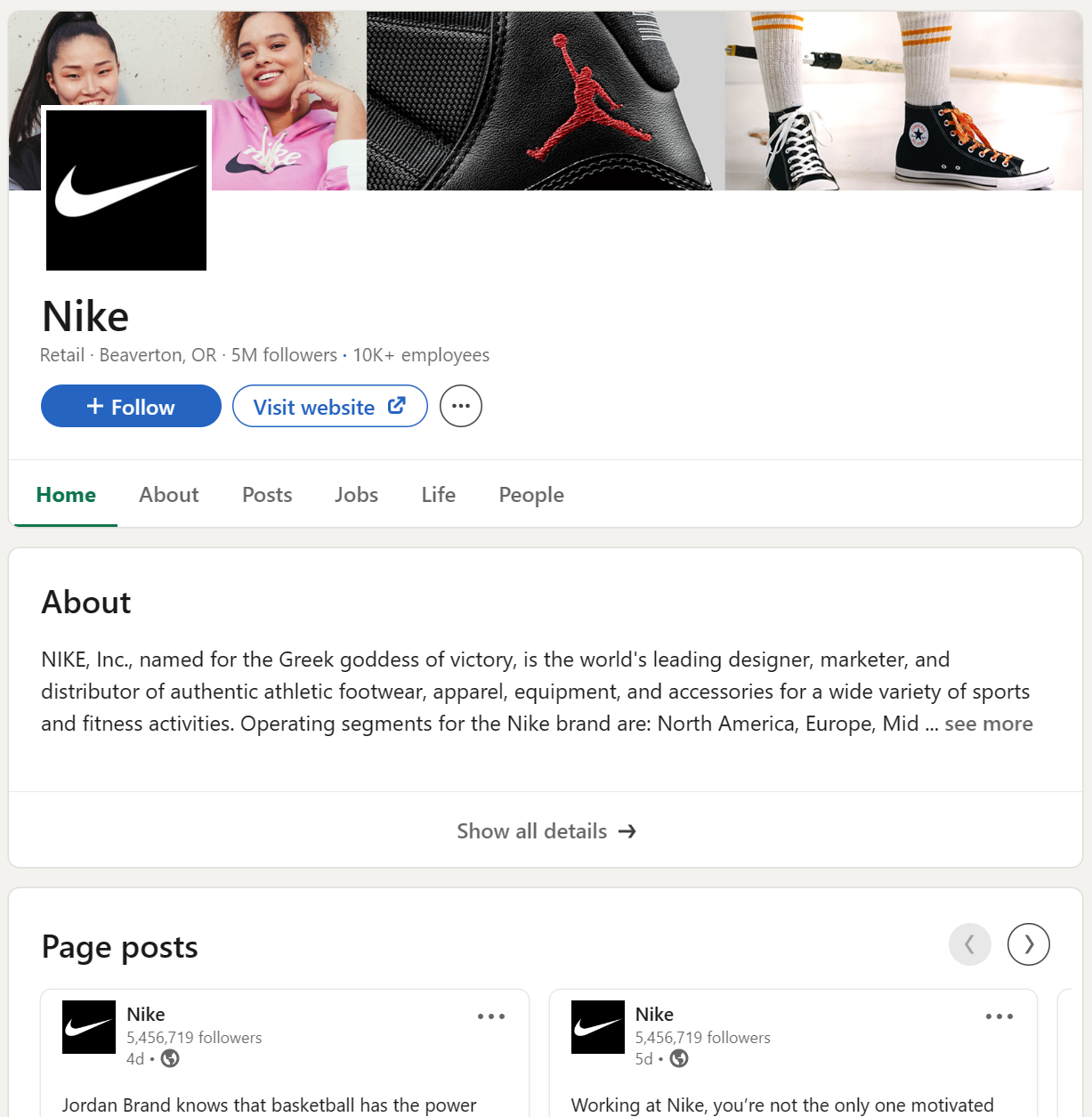
Image: LinkedIn
You can include whatever content you want but, like Nike’s page above, having detailed “Home,” “About,” “Posts,” “Jobs,” “Life,” and “People” sections is a standing recommendation. Adding a products page, meanwhile, lets you showcase your offering or a downloadable file that could interest prospects.
A page that summarizes your brand helps as well, so here are some ways to optimize it for engagement and visibility:
- Build an initial following: Tell employees and customers about your LinkedIn page, using channels like email and other social platforms to spread the word. Place links and follow buttons on your website as well.
- Capitalize on brand assets: For better recognition, use the company logo as your LinkedIn page’s profile picture and an eye-catching image as your banner. Make sure it sports brand colors or includes a call to action (CTA).
- Regularly polish your “About” section: Highlight your company’s mission, vision, values, and history. Keep information up to date, succinct, and free of spelling and grammatical errors.
- Include keywords: These help you appear on relevant LinkedIn searches, so choose them wisely.
Your LinkedIn profile’s success is a team effort, so seek employee input when creating content. This helps you gather information and post about various topics that audiences find interesting.
Treat employees like your audience
Create an internal source of traffic by making your LinkedIn profile valuable to workers. Use it for purposes they’ll be receptive to, like:
- Sharing the information they need: This can include company updates and anything relevant to employee affairs.
- Recognition: Showcase individual or team successes, as well as company culture.
Offer training
Provide learning opportunities that strengthen employee resumes and LinkedIn profiles. They enjoy the process of building their online presence, and you help them become thought leaders in your industry.
Add personality
Your LinkedIn page has built-in features that enable content optimization and sharing, as well as clear communication with prospects. It’s designed and tested to let brands feature what they want, garner attention, and compel engagement through well-placed CTAs.
For instance, you can showcase upcoming products from your development pipeline, along with the employees who work on them. Think about pieces, content from workers, and posts that show off your culture work as well.
Showcase your team
Prospects often click through employee profiles before deciding to work for your company.
By showing off your human capital as a primary appeal, you can strengthen your employer brand and draw interest from candidates. So, encourage your personnel to contribute to the company page.
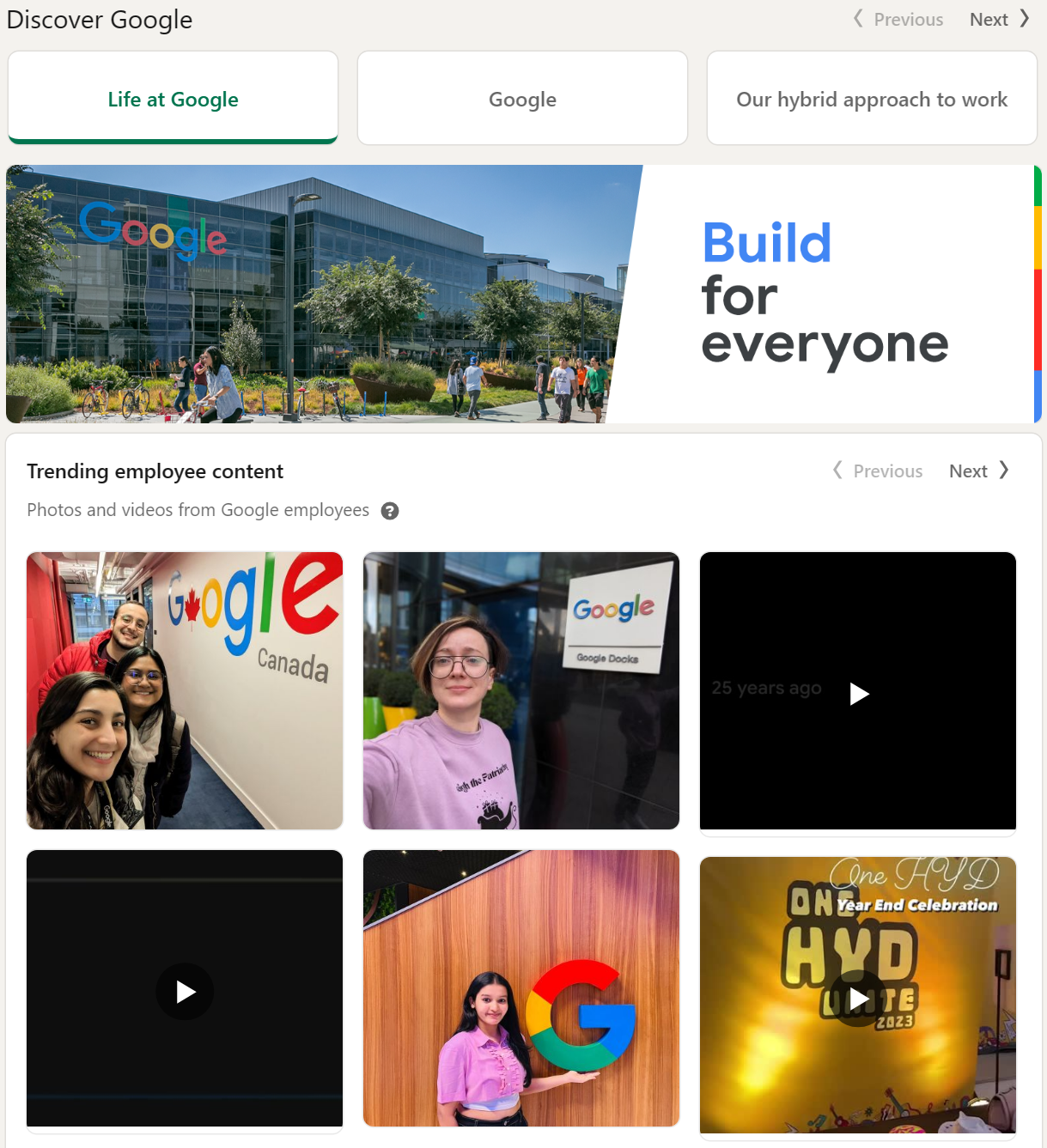
Image: LinkedIn
For example, Google’s profile has a “Life at Google” section dedicated to exhibiting employees’ posted content.
Optimize your personal profile
Similar to your company page, when recruiting candidates online, your personal LinkedIn account is your trademark. It not only represents you and the brand you work for but also promotes professionalism and builds credibility.
If a prospect visits your profile and it’s empty, they’ll most likely leave, so complete your page before reaching out to people. Fill out your information and take the following actions:
- Make sure people can see the company you’re hiring for
- Post content that reflects the organization’s culture
- Use appropriate hashtags and tags
- Ask for references
If you’re an external recruiter, be specific with job postings, tailoring them to the company you’re hiring for. When seeking candidates for multiple organizations, differentiate your listings.
A polished profile shows you’re trustworthy during the recruitment process. And, when associated with a company, simply visiting your profile can compel prospects to research it.
Build attractive job listings
Quality job listings make or break your hiring efforts. They can link to ads, recruiters, and hiring campaigns and so cast a wide net.
LinkedIn offers tools for creating and promoting listings, including resumes, branding, search filters, advertising, and more. A few cost money, but they’re worth it. Here are some tips that can help you maximize these assets.
Use the “Open to Hiring” feature

The “Open to” button underneath your LinkedIn profile picture lets you enable a “Hiring” option that informs users when you’re entertaining applicants. This lets prospects apply through the platform and reduces the time they spend on typical job application processes.
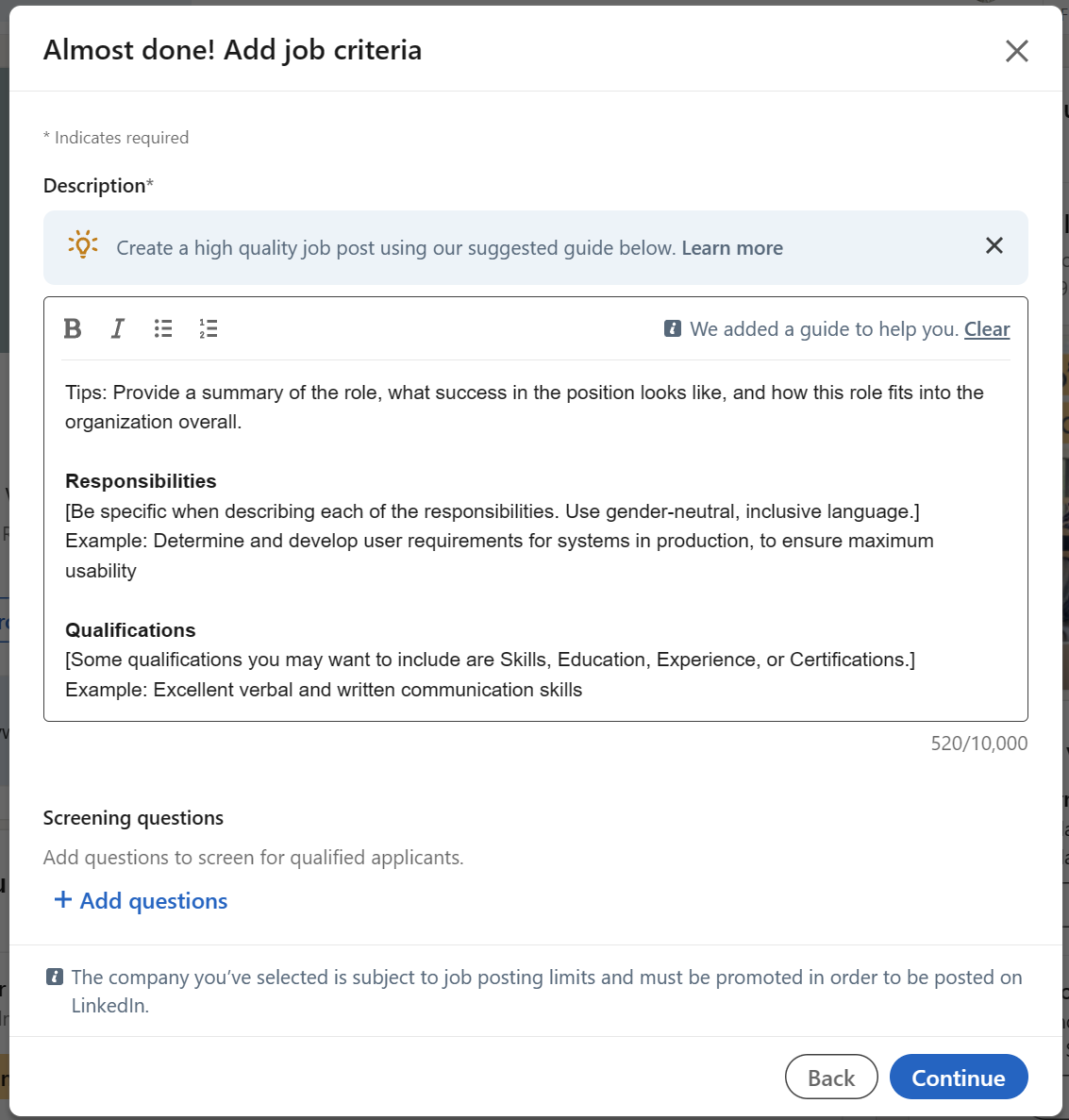
While it can lead to spam, it attracts more casual candidates who may be fit for other roles as well. LinkedIn applications also let you see an individual’s resume and profile, so verifying the information they send is easier.
Also, make sure to add screening questions. This filters out unqualified candidates and cuts down on spam.
Be thorough
To avoid confusion and keep prospects fully informed, describe the role in detail, including:
- Internal information (if possible)
- What software or tools will be involved
- Hard and soft skill requirements
- Transparent compensation
- Team information (whether some work on-site or from home, the possibility of a flex setup, what team prospects will be assigned to, etc.)
Remember to link your listings to company profiles as well.
Craft targeted ads
This boosts engagement by landing your job posting in front of the right people, which ensures only relevant applicants see it.
Clearly define the required skills and use keywords
Like LinkedIn profiles, featuring the right keywords enables your listing to appear in relevant LinkedIn searches. It also improves search engine optimization (SEO), which helps your advertised vacancy rank in Google. The same applies for the role’s necessary hard and soft skills.
Get your team involved
Internal branding not only promotes company values and culture among employees but also supports a positive brand image and, in turn, draws in prospective hires.
A study on employee advocacy revealed that, on average, 50% of workers share photos and videos on social media about their jobs, and one third of them do so with no encouragement from their employer.
Further, engaged, productive, and happy teams are more likely to refer talent to your organization, and share positive stories with friends, peers, and loved ones — 88% of whom put their faith in brand recommendations from those they know.
By recognizing (and leveraging) employees as your loyal ambassadors, you can attract and hire more skilled individuals.
Identify internal brand ambassadors
A brand ambassador speaks highly of your brand to relevant audiences. To find potential spokespeople, look for employees who:
- Try to find ways to be effective or helpful
- Talk to internal experts or managers about your brand to ensure they’re on the right path
- Share insights on how the company can improve
- Think about your brand and/or their role outside the workplace
- Consistently show up inspired
- Share content online related to your organization’s initiatives
It’s also important you encourage these qualities on a larger scale and help your culture flourish.
Add a human touch to recruiting and onboarding
The moment an offer letter is sent to a new hire, welcome and engage with them until their first day of work. Whether it be on LinkedIn or through some other channel, maintain regular contact. At this stage, you should also:
- Make a positive first impression: Excitedly introduce the team and take time to get to know the new member.
- Assign buddies and mentors: A buddy system supports new hires through their early days at the company and ensures they have someone available to answer their questions.
- Encourage feedback: Regularly check in to see what candidates think about the recruitment and onboarding process. Ask for suggestions to improve it.
- Keep people in the loop: Constantly communicate with the new hire’s team. Give them updates throughout the process, especially during the final stages. Let them reach out to candidates and connect early to begin building rapport.
Remember, employee engagement levels will vary based on how much you encourage them. Keep them close to the action, tell them how the company is doing, and offer growth opportunities. In the long term, they’ll become your largest source of prospects and leads.
Network, network, network
Networking builds and nurtures professional relationships and so should always be part of your long-term recruitment strategy.
By offering value, cold contacts can turn into leads. Then, the connections you form can result in access to groups filled with people from your industry or niche, as well as job seekers. Take note, though, that cultivating relationships the right way entails a significant time investment.
Join groups
LinkedIn groups are either open or private communities where people share their expertise and thoughts. Unfortunately, marketers also take advantage of these groups to promote company content, making it difficult to pinpoint legitimate, experienced candidates.
However, by being active in LinkedIn groups, you can provide insights, connect with industry professionals, and establish a strong employer brand. So, participate in discussions by both asking and answering questions. You can share open positions as well, but don’t spam the group with job ads.
Utilize search filters
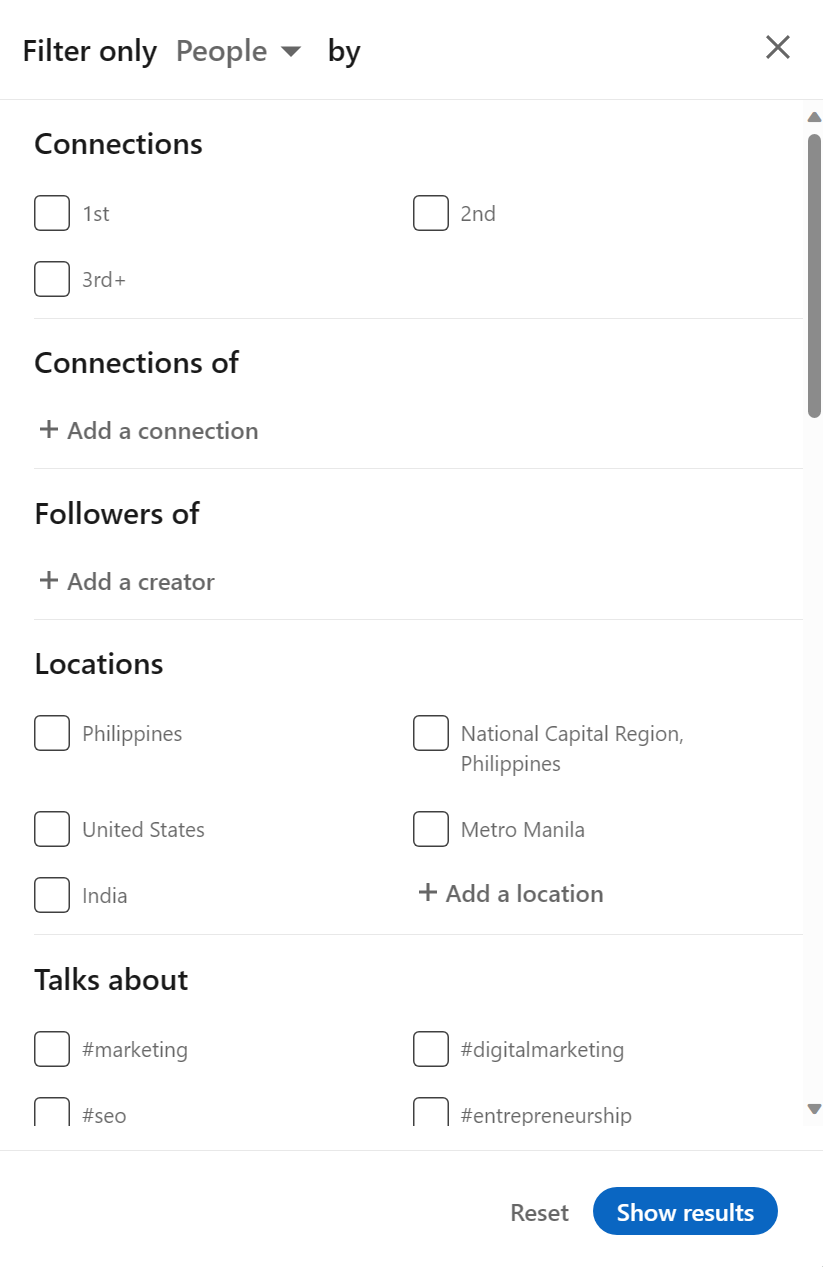
Filters let you easily search for prospects according to factors important to you like location, experience, occupation, and more. Build a profile of your perfect candidate and match them with the right filters to find qualified individuals effortlessly.
Use hashtags
Hashtags help you find posts relevant to your industry, as well as your HR and recruitment efforts. Choose and follow the right ones to hone in on the right job seekers and content.
For instance, you could search for broad hashtags like #softwaredevelopment and #digitalmarketing or use localized ones like #Manila or #NewYorkCity. It takes a bit of research but it’s worth it to help narrow your candidate pool.
Responsiveness is key
LinkedIn provides a direct line to followers, industry professionals, and potential candidates, but to build relationships, you must actively engage with them. Pay attention to the content they share, the quality of their posts, and how they brand themselves online.
These provide opportunities to connect, so, whether it be through comments or direct messages, interact when possible.
Don’t neglect cold contacts
Cold contacts can include passive candidates or people who qualify for roles you may not need yet but are still future prospects.
By investing time to foster relationships with them now, you keep them on the back burner as a potential hire down the line. Doing so while asking for nothing in return may also compel them to send referrals your way when you post an open position.
Try direct outreach
Direct outreach is an up-front tactic, so you have to tread carefully; coming off as pushy or spammy can discourage people from engaging.
Research before initiating contact
Generic template messages can be the worst thing a candidate receives. To show genuine interest and respect towards a prospect, personalize your message. Take advantage of the communication to pique their interest with relevant content.
This necessitates learning about your candidate, so look up their LinkedIn profile to gather the intel you need.
Offer value
Whether you’re reaching out about a current vacancy or a position that may open in a year or two, always offer value.
This could take the form of access to free training, valuable information, or a free review of their resume. That investment gets you in the door and builds trust so that, by the time you offer an available role, the relationship is well established.
Screen candidates using LinkedIn
LinkedIn, as mentioned, lets you learn about candidates before you meet them. To help you find someone who can fit in your organization, here are some factors you need to consider:
- Professional online behavior: Poor conduct on LinkedIn is a red flag. If a candidate participates in aggressive arguments on the platform, they may have a combative personality. That inability to compose themselves online may in turn manifest in the workplace as well.
- How a candidate communicates: If the applicant can’t effectively or professionally communicate, think twice. Avoid those who interact in a rude, passive-aggressive, or arrogant manner. If this is how they speak on a social platform for professionals, that’s what you can expect (and worse) on a team.
- Indications of expertise: Photos from work events, conferences, links to educational content, and shared posts from industry leaders show that a candidate is active in their field. Certifications and testimonials from peers are also major green flags.
- Creative content: A display of innovative ideas and solutions for specific problems and industries indicates independent thinking. Prospects who post this type of content possess the potential to become unique decision makers and, possibly, leaders.
- Content that displays personality: LinkedIn can offer insights about an applicant’s habits and interests in a professional context. If they showcase some of their hobbies, even better. A prospect’s LinkedIn content will typically be geared towards work, but other aspects show how much personality they’re willing to bring to it.
Use LinkedIn Business Solutions
Linkedin Business Solutions provide four tools specifically for hiring, advertising, selling, and learning. For your HR and recruitment needs, however, I focus on three.
Linkedin Talent Solutions
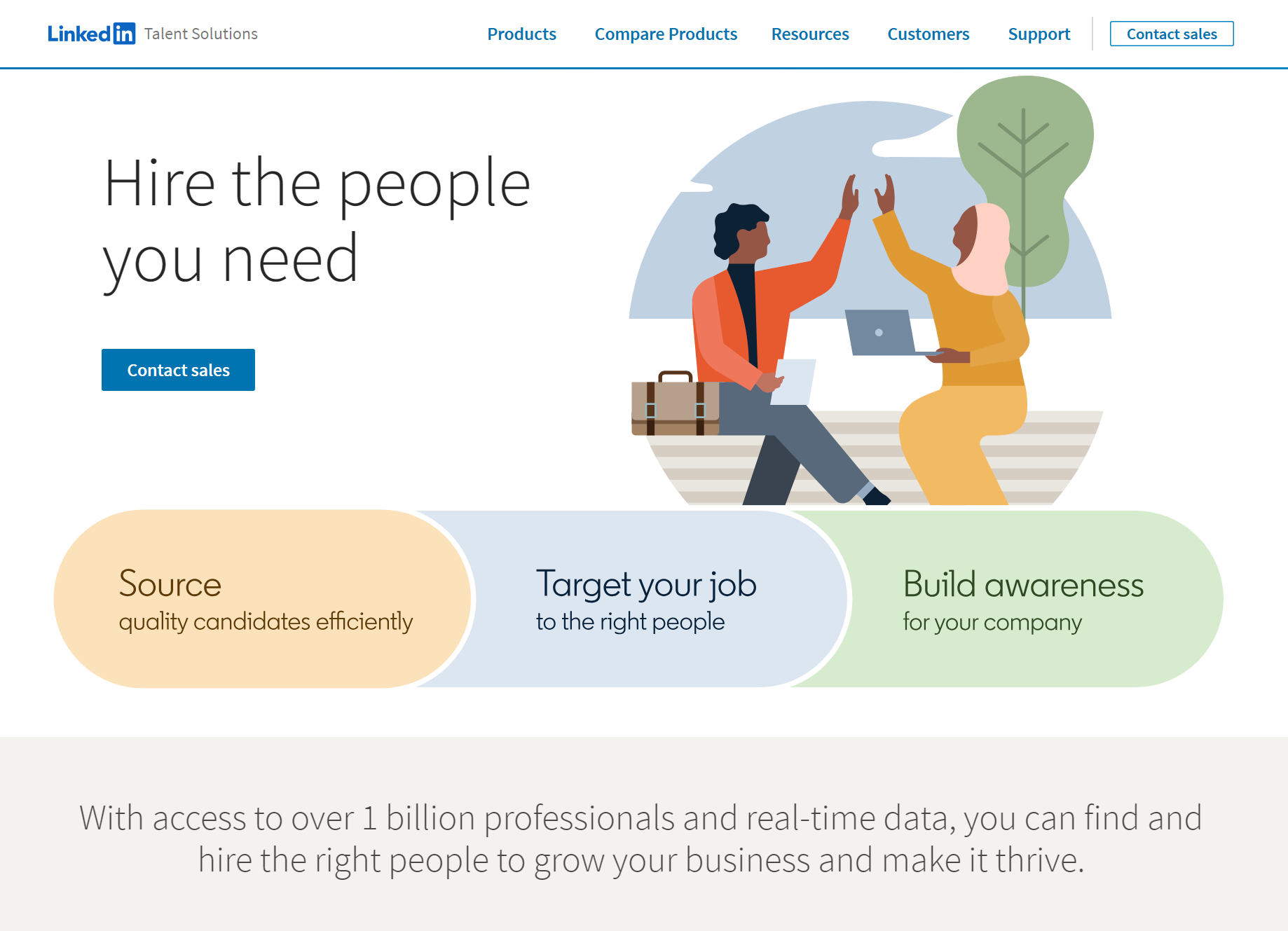
Image: LinkedIn
Talent Solutions offers three tools that streamline qualified candidate sourcing, job ad targeting, and employer brand building:
- LinkedIn Recruiter: This platform lets you connect with and manage pools of qualified candidates. It possesses advanced search filters, intelligent job matching, personalized messaging, as well as collaboration and analytics capabilities.
- LinkedIn Jobs: This allows you to post open roles quickly, then target and select the best applicants. Additionally, insights help you prioritize candidates and promote roles that are difficult to fill.
- LinkedIn Career Pages: With this tool, you can build a content-rich LinkedIn page where you share company news, employee testimonials, curated workplace content, and personalized job recommendations.
LinkedIn Learning
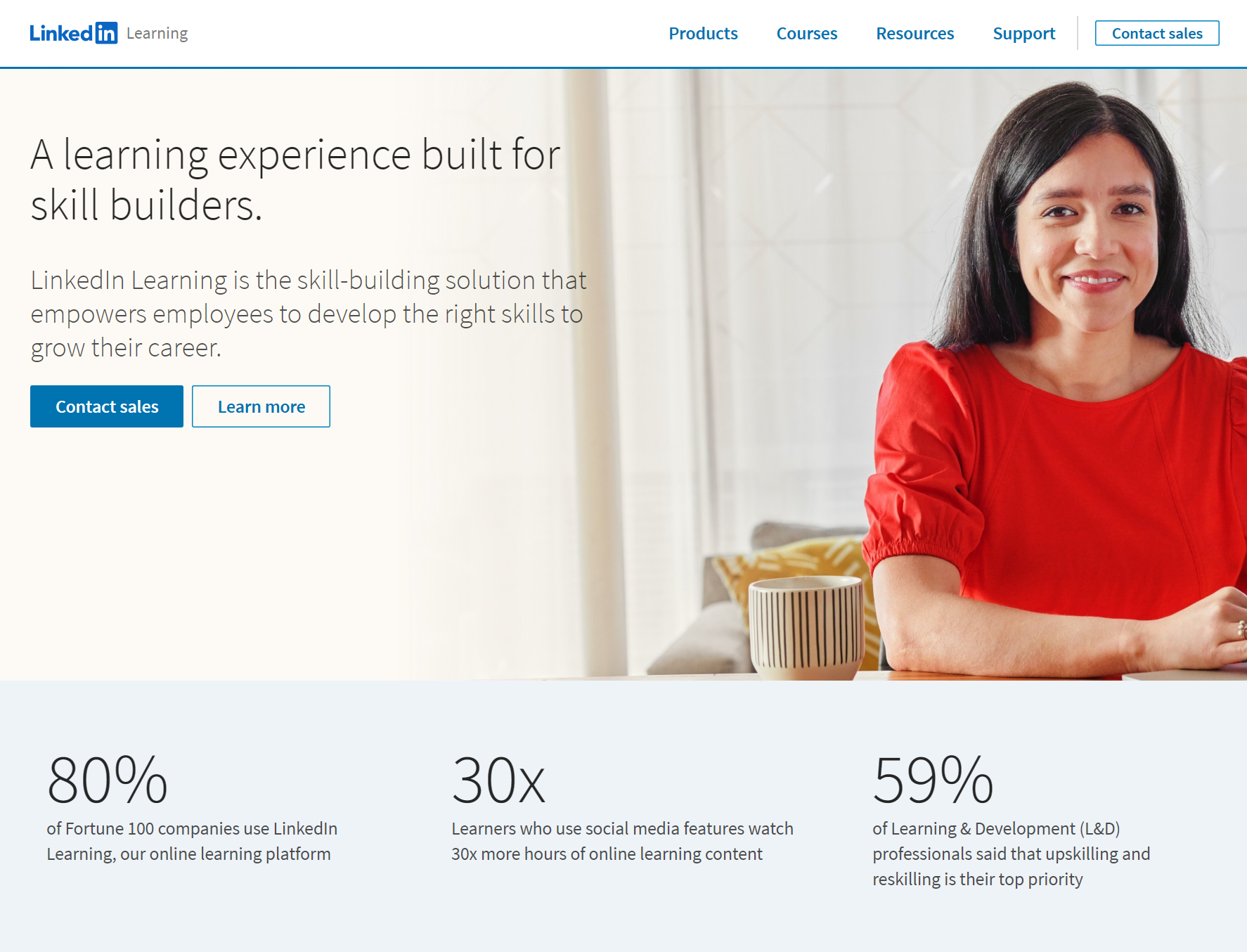
Image: LinkedIn
Professional development opportunities attract and retain employees, and Learning enables you to provide them.
It boasts over 16,000 courses in seven languages, providing a wealth of knowledge for the 74% of workers who want access to independent learning during their spare time at work. On this platform, they can enjoy educational materials curated for building in-demand skills at their own pace.
Community features also let them connect with instructors and experts across the platform, while analytics let you tailor employee training and development.
LinkedIn Marketing Solutions
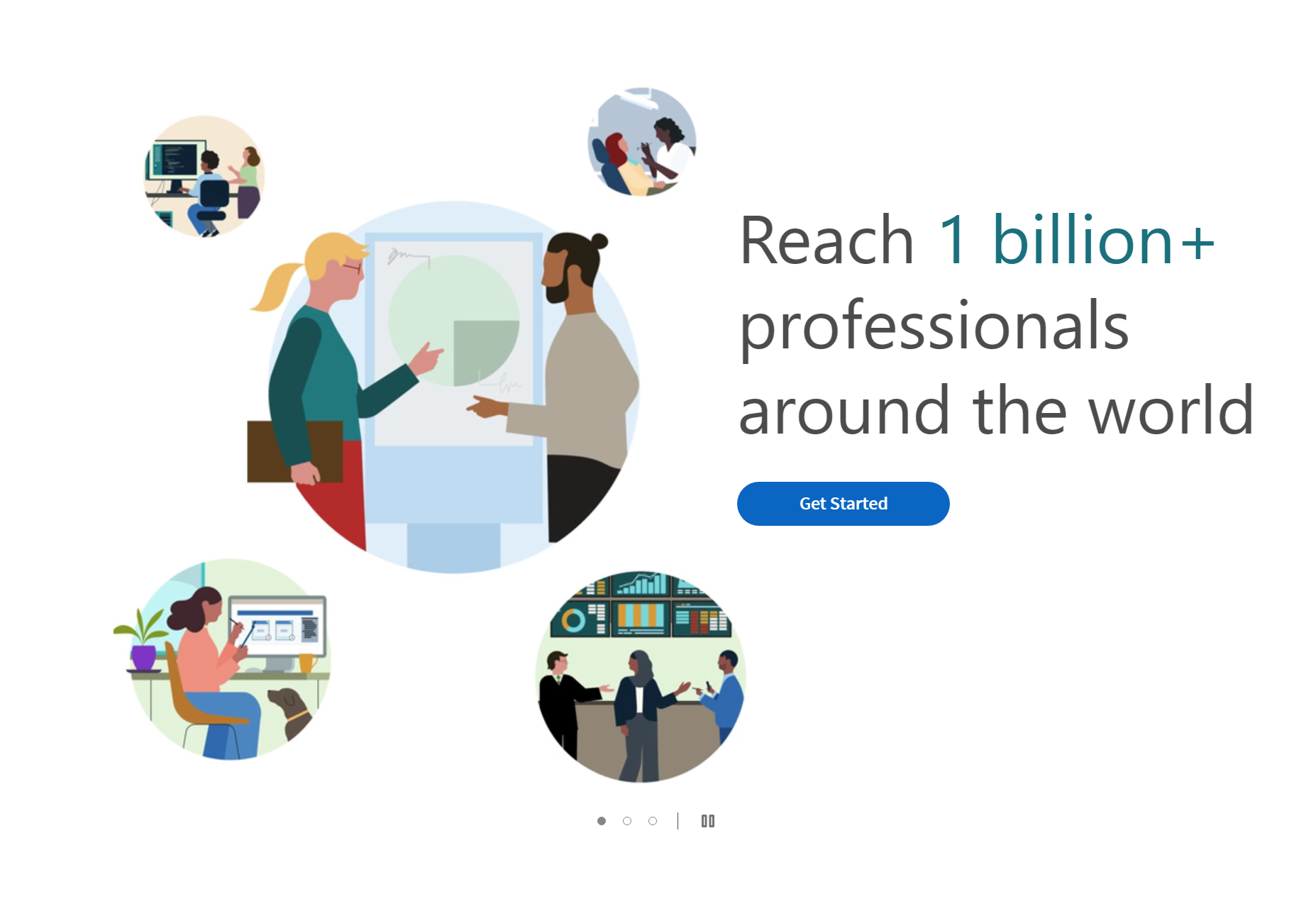
Image: LinkedIn
Marketing Solutions equips you with a strong toolkit to build strategic LinkedIn campaigns that put your company in the spotlight. This extensive asset lets you:
- Create initiatives based on your goals
- Target audiences according to job titles, skills, industry, etc.
- Measure campaign performance through reporting and analytics
With these capabilities, you and your marketing department can create, for example, “Work With Us” ads that share employee testimonials and show prospects expressing what it means to work for your organization.
Overall, Marketing Solutions facilitates the clear communication of your organization’s values to specific audiences and strengthens employer branding.
How to run your LinkedIn strategy

With the above tips in mind, you can now build a plan of action, then carry out your HR and recruitment efforts on LinkedIn. Here’s a basic overview of what the process should look like.
Step 1: Outline your goals
Your objectives drive your strategy, so clearly identify these up front. You can adjust these based on your budget, the team’s involvement, and the number of hires you need. To start, answer these questions:
- How far ahead are your hiring plans?
- What’s your turnover rate? Do you have established contacts who can fill roles as they empty?
- Are you adding new, future roles, and do you plan to gather prospects before hiring becomes an immediate necessity?
- Can you work with teams to post and share listings in their own networks?
Step 2: Construct candidate profiles
Once you address the above concerns, pinpoint the roles you want to fill and develop profiles of your ideal candidates. A clear understanding of the people you want to target helps you develop messaging that resonates with them. For instance, what works with executives may not land with managers.
Step 3: Set key performance indicators (KPIs)
KPIs measure whether your initiatives on LinkedIn bear fruit. Here are some examples based on specific objectives:
- Diversify candidate pool: Your diversity indicators depend on factors such as age, gender, ethnicity, and other demographics. To gather LinkedIn prospects from numerous groups, you’ll need to connect with their communities and use inclusive messaging.
- Boost job listing traffic: Besides increasing visibility through paid advertising, optimized SEO and relevant hashtags are also vital to draw in applicants. If possible, share the job ad across multiple channels, like your website, newsletter, and social media pages.
- Capture [X] amount of candidates: Elements that enhance engagement, such as images, videos, CTAs, and testimonials, will garner more attention from prospects.
Step 4: Build your LinkedIn page
Your LinkedIn profile acts as the company’s digital representation on the platform. In this step, it’s of utmost importance that you provide complete brand information through the following actions:
- Clearly communicate your mission, values, and goals
- Incorporate high-quality photos that show off your organization, workplace, and employees
- Regularly post content, whether it be blogs, videos, industry insights, etc.
Step 5: Create and post the job ad
Now that your LinkedIn page is set up, it’s time to craft your job post. I’ve already discussed best practices, but here are a few additional tips to produce top-notch listings:
- Clear job titles make your listing easier to understand. Avoid quirky names like “Digital Overlord” for a web developer opening
- Don’t try to dress up or hide the mundane tasks. Outline all of the position’s responsibilities so potential candidates know what they’re signing up for.
- Besides expanding visibility, keywords also enhance readability. Insert them strategically but naturally throughout your posting so candidates will find your listing more comprehensible.
- Contact information is a must. Applicants may have questions, so make it easy for them to reach you.
- Visuals break up the monotony of text and make listings more engaging. For instance, show off job-related benefits like workshops and professional development opportunities.
Step 5: Detail the application process
Enable job seekers to apply directly through LinkedIn and ask screening questions that immediately pre-qualify candidates. Since 60% of job seekers have abandoned an application due to a long and complex process, you absolutely need to streamline yours.
Remember to be transparent about how the procedures will unfold. Share information such as:
- The requirements they should prepare and where they’ll submit them
- How long the whole process typically takes
- When initial interviews occur
- Whether they’ll need to complete any assessments
Regularly provide status updates as well and tell them what will happen after each successive step.
Step 6: Screen candidate profiles
I previously pointed out key characteristics to look for while sifting through applicants’ LinkedIn profiles. These will help you in this step, as your main goal is to shrink your pool of candidates to the most qualified ones.
Step 7: Invite applicants for an interview
At this stage, you should have a collection of ideal applicants ready. The next step is to have a one-on-one conversation with each of them, whether it be in-person or virtually.
Invite them through LinkedIn and hold an initial meeting. If you like the candidate, strive to make a good first impression. All who pass will then move further along your hiring and onboarding process.
Wrapping up — Fruitful LinkedIn recruiting requires a thoughtful approach
Once your LinkedIn initiatives are in motion, your top candidates will reach the end of your recruitment funnel and land the given role. To get to that point, however, requires well-thought-out tactics tailored to the platform.
To take your HR and recruitment efforts on LinkedIn to the next level, remember to:
- Build a complete profile
- Research your candidates
- Craft listings based on what resonates with prospects
- Enhance brand engagement and interest by regularly posting content
- Make the application process easier
- Take advantage of LinkedIn’s many features and tools
Make necessary adjustments to your LinkedIn strategy to drive you closer to your HR and recruitment goals.




